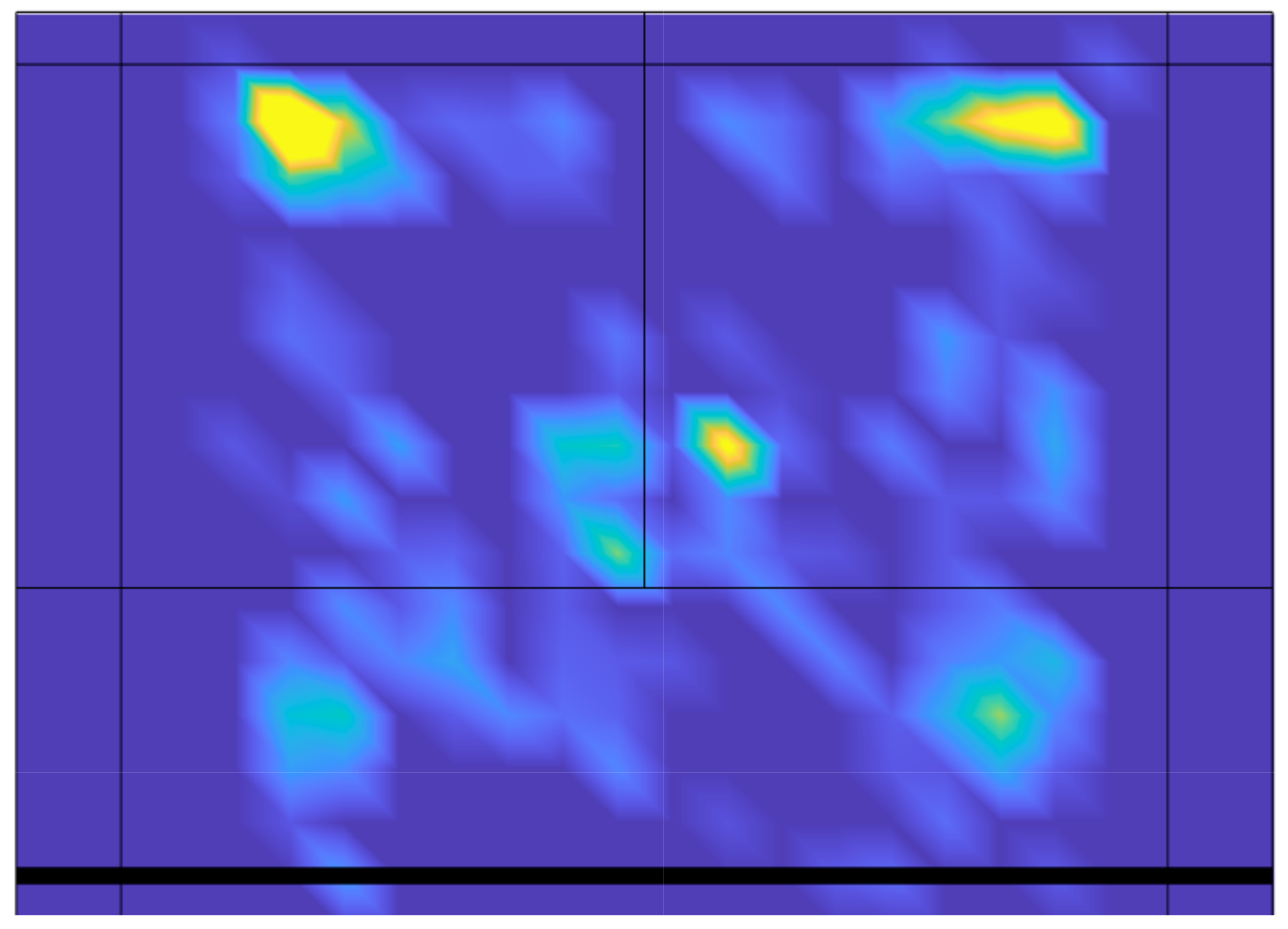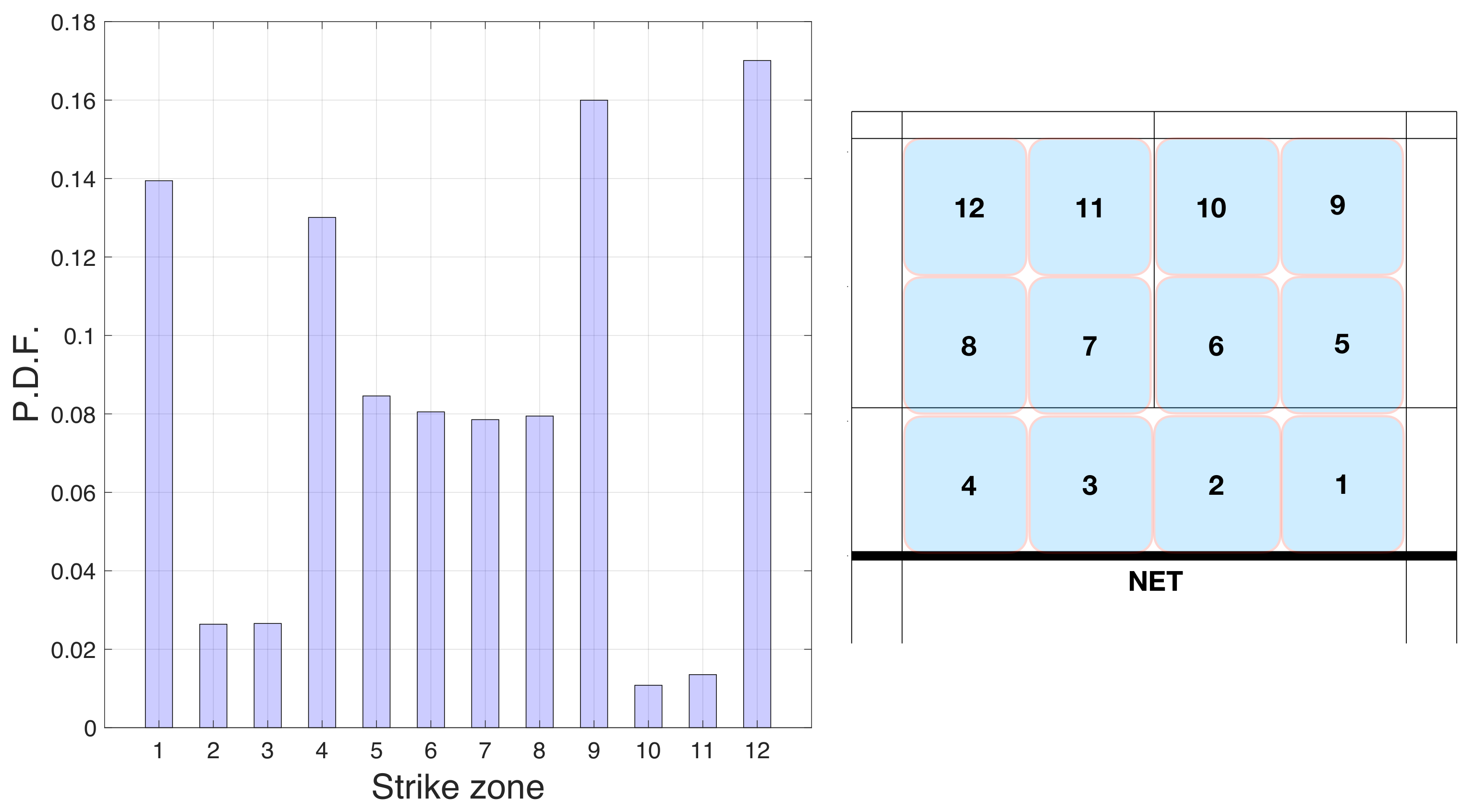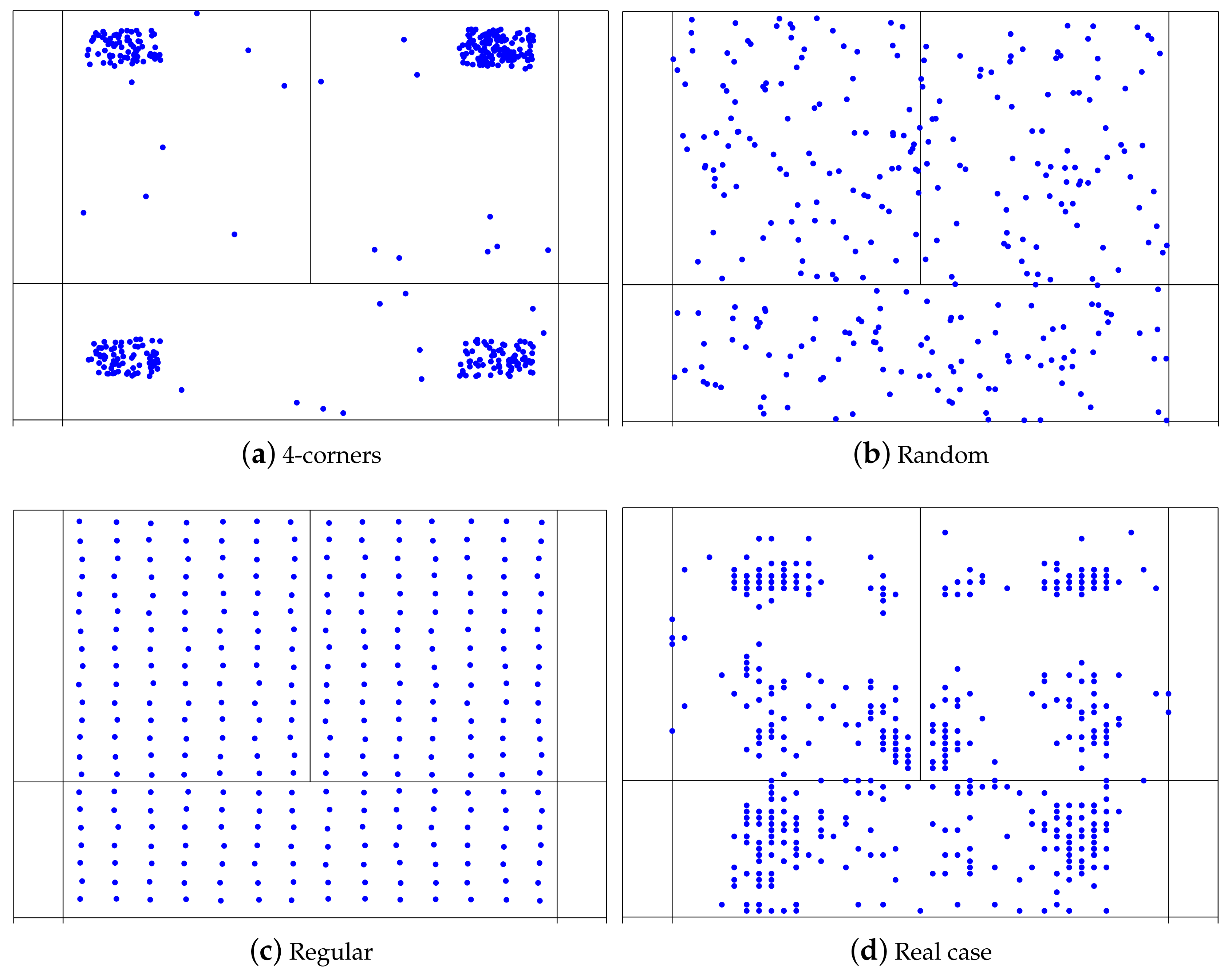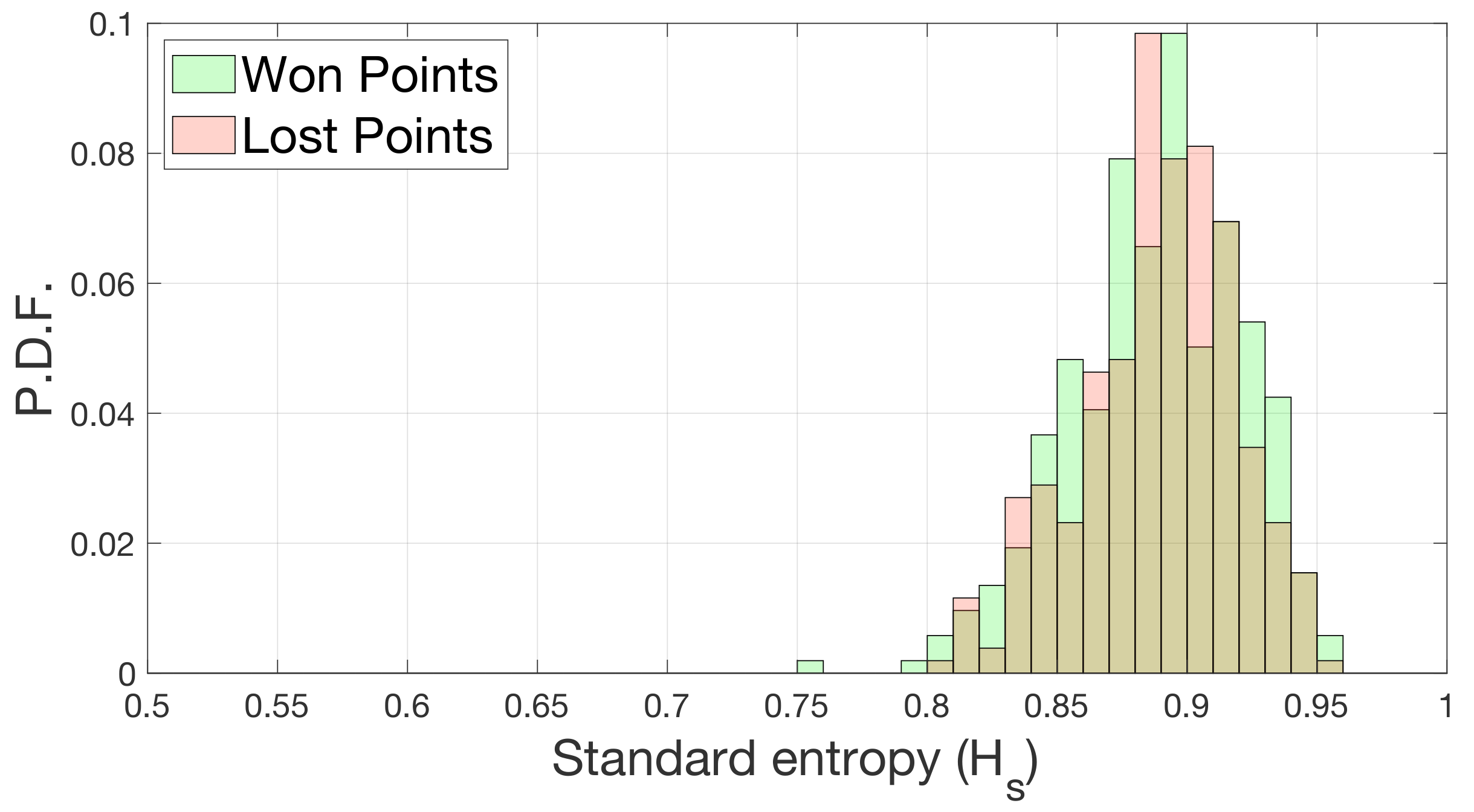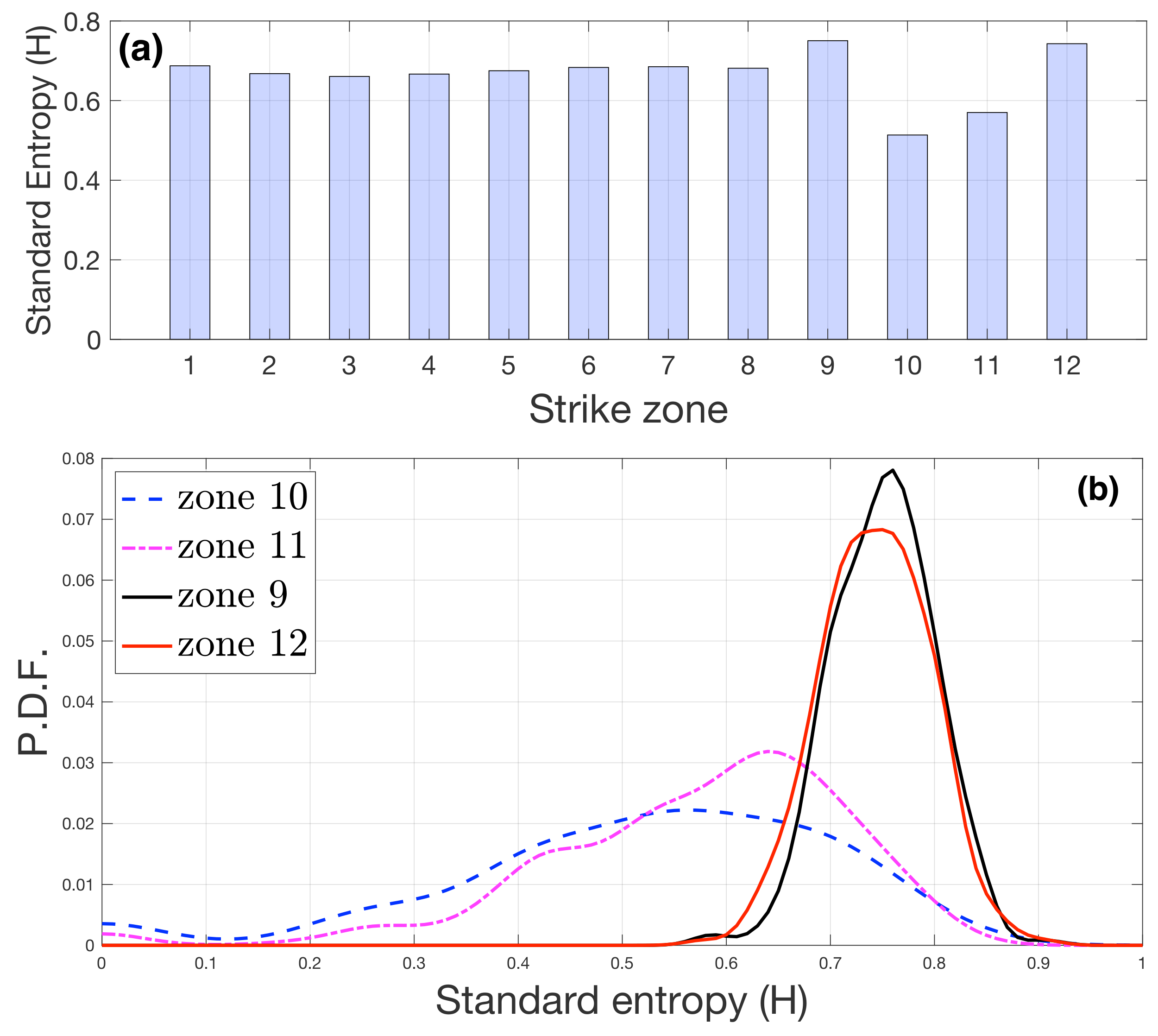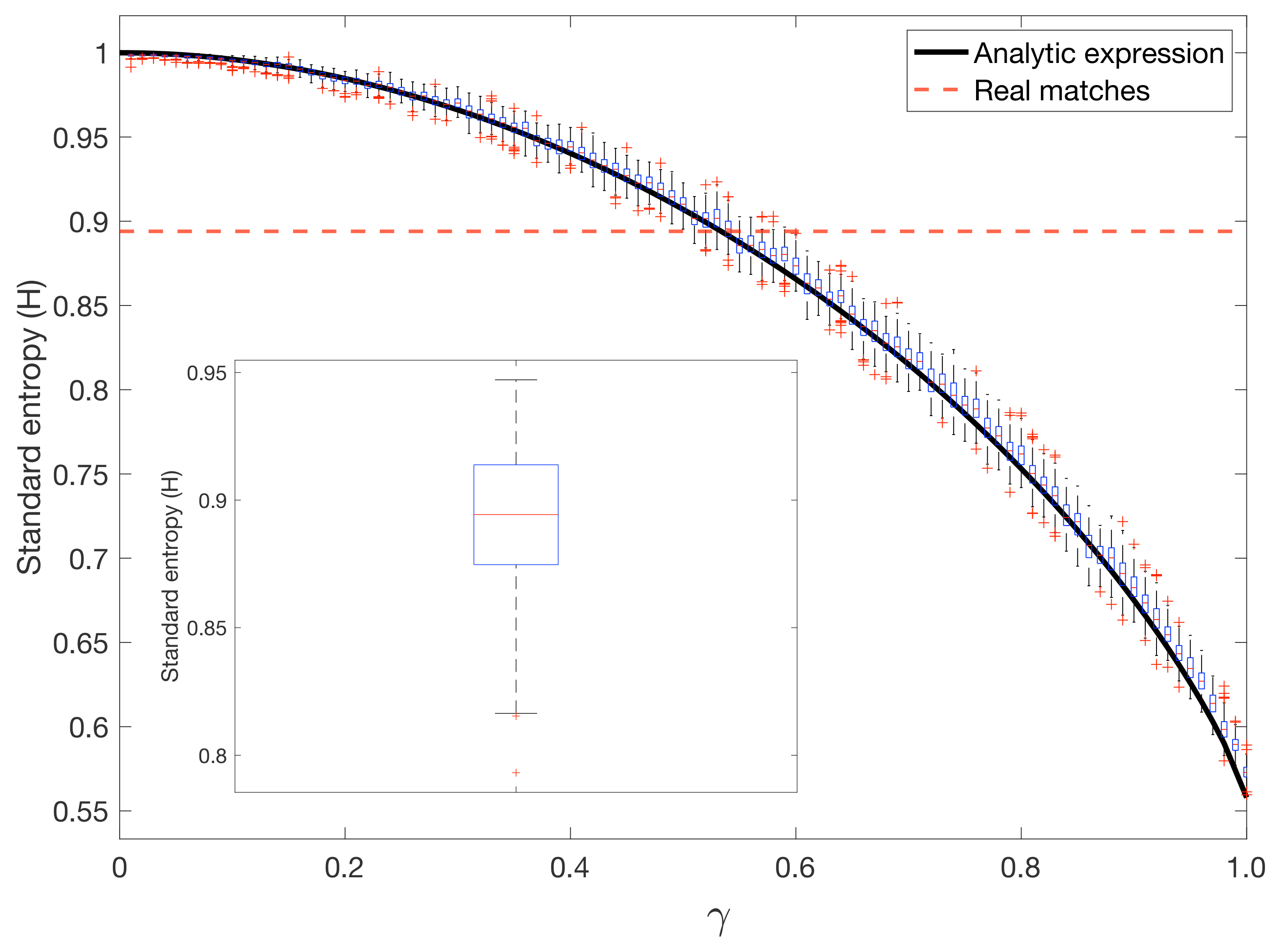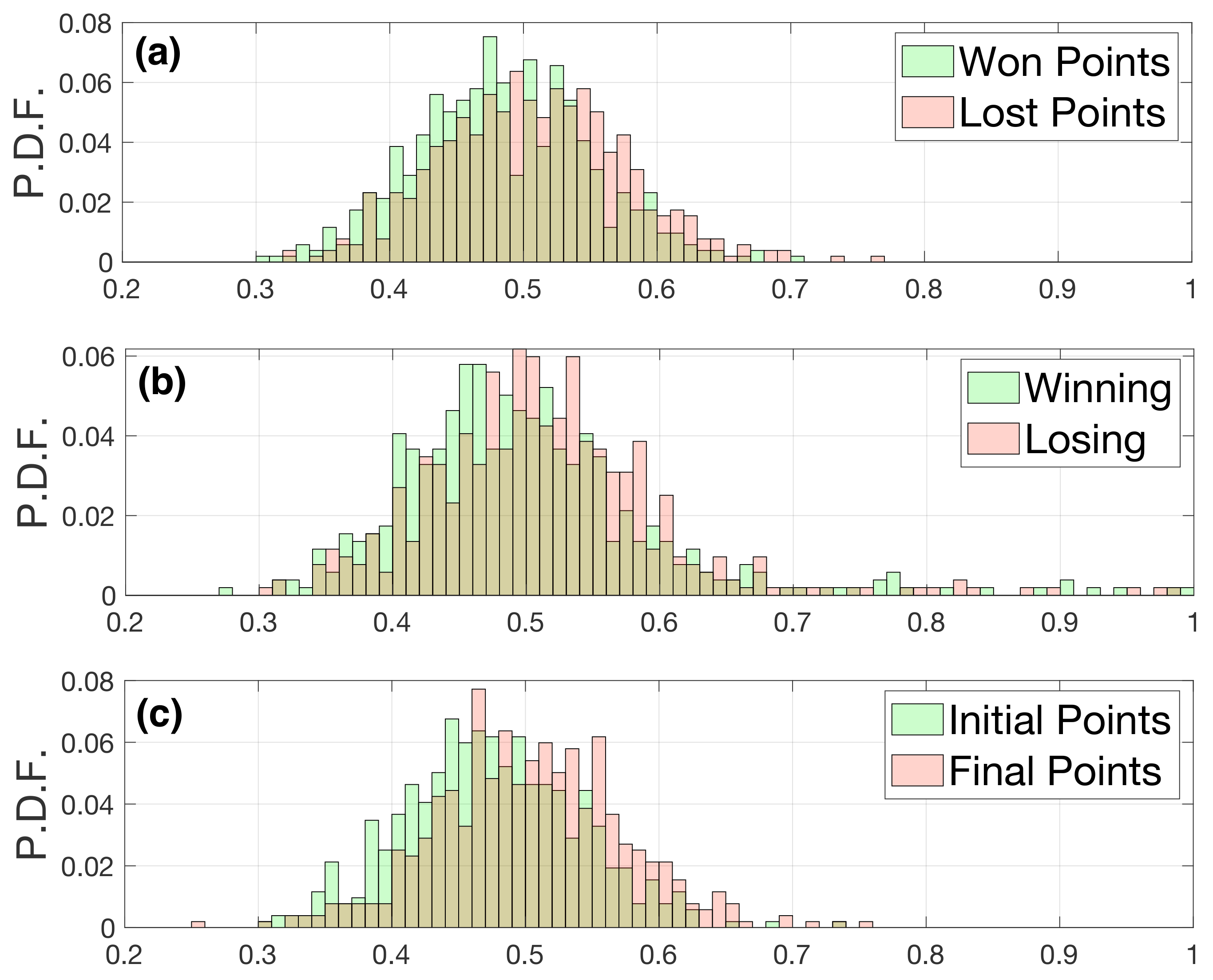1. Introduction
Badminton is one of the most popular sports in the world, with more than 200 million players [
1]. The factors for winning a point in badminton are multiple, revealing the complexity of the sport [
2]. In particular, badminton is a high-speed sport characterized by high-intensity actions interspersed by periods of effort and pause.
Research has widely described the statistical aspects of the temporal structure of badminton matches [
1,
3,
4]: (i) the match duration is about 45–65 min; (ii) the average duration of a point is approximately nine seconds; (iii) the number of strokes per point is about 8–10. Additionally, other studies have focused their attention on understanding the differences between these parameters when considering the context, such as gender, modalities, or situational variables (number of sets, intervals of play, quality of opponent, etc.) [
5,
6,
7,
8].
On the other hand, most of the badminton literature has focused on predicting winning and losing players using key performance indicators, such as the type of service, the type of stroke, or the temporal parameters [
1,
3,
5,
6]. However, the spatial-related variables were not addressed to identify how the space of play (where each player hits the shuttlecock) was used during badminton matches, and then how these complex behaviors may identify badminton performance profiles.
Due to the different scales of the aforementioned parameters and the complexity of the game, the need to study different time scales using methodological tools of complex systems is present [
9]. In particular, entropy has been used as an indicator related to the complexity of different sports [
10,
11]. For example, Couceiro et al. [
12] have used entropy-based techniques to assess human performance variability in three different case studies: golf, tennis, and soccer. In team sports, Silva et al. [
13] detailed how different measures of entropy have been applied to the study of performance variability to uncover the interactions underlying players’ and teams’ performances. In the particular case of soccer, Martinez et al. [
14] have used spatial and temporal entropy to analyze the level of randomness of football passing networks, showing different levels of entropy in different teams.
Regarding badminton, however, there is still a diversity of methodologies, including assessing the level of entropy, that has yet to be utilized. In this article, the aims are twofold: (i) to investigate the distribution of the strike positions of badminton players by quantifying the corresponding standard entropy and an alternative metric (spatial entropy) related to winning and losing points and random positions; and (ii) to evaluate the standard entropy of the receiving positions. We investigate the amount of randomness associated with the position from which a player strikes the shuttlecock. In
Figure 1, we plot the heat map of the striking positions of 259 badminton matches. As we can observe, the distribution of strokes seems to have some preferred regions; however, it is not homogeneous. Therefore, with the aim of understanding how random these patterns are, we first quantify the standard entropy of the striking patterns and relate it to the probability of winning a point. Next, we use an alternative metric to evaluate the entropy, which, in this case, is more related to the spatial positions of the strokes: the spatial entropy [
15]. Both entropy indicators point in the same direction: there is no difference in the entropy distributions for the winning and losing points. Finally, we present a theoretical model to evaluate the level of randomness of badminton striking positions, showing the coexistence of random forces and the preference for particular locations on the court.
3. Results
3.1. Distributions by Zones
To understand the importance of the hitting zones, we first studied the distribution of the number of times that players hit the badminton shuttlecock from each of the 12 zones indicated in
Figure 2. In
Figure 2 we present a bar graph containing the probability distribution function (PDF) of all the zones. We can see that the four corners of the court (zones 1, 9, 4, and 12) were the most visited places by the players (17%, 16 %, 13.9%, and 13% of all strokes, respectively). These results reflect the pattern structure of a badminton match. In particular, back corner zones 9 and 12 are the two zones where players hit the most. Corners forward 1 and 4 positions follow. On the other hand, region 10 has the lowest percentage of strokes (only 1.1 %).
3.2. Standard Entropy
Next, we calculated the standard entropy (
H) of our datasets using the information from the zone associated with each stroke calculated for each match. To understand if the behavior of the players was different when they were winning or losing, we divided the rallies into wins and losses to compute the entropy. For each match, we allocated hitting zones based on the player who won the point and the one who lost it. Based on those data, we calculated the standard entropy and repeated it for all matches. In
Figure 4, we show the probability distribution of the standard entropies for points that were won and lost, which have been calculated using Equation (
1) while separating winning strokes from losing strokes. In green, we can see the entropy distributions of the positions of the winning strokes and in red the positions of losing strokes of each match.
We can observe that there is no difference between the two entropy distributions. We tested whether the mean values of the distributions are equal using a paired t-test with a p-value greater than 0.5.
On the other hand, we studied the entropy of the receiving areas. To calculate this entropy, we first obtained the two-time sequences. We calculated the numbers of times the sequences appeared in the match; for example, if we wanted to study zone 1, we calculated the sequences 1–1—a hit from zone 1 received in zone 1—and 1–2, 1–3, …, 1–12. Then, we obtained the probabilities of the sequences, and finally, we obtained, using the standard entropy equation, the entropy of the position 1, and the same for the other zones. These values gave us an idea of the variability of the zones where the badminton shuttlecock can be sent from each zone.
In
Figure 5a we show the average receiving entropy of all matches.
Figure 5b shows the PDF of the entropy per match of the most different zones. The zones 10 and 11 had the lowest values; the zones 9 and 12 had the highest values.
3.3. Modeling Badminton Entropy
To understand the meaning of the standard entropy values, we carried out a series of numerical simulations implementing two types of striking patterns: (a) hitting the shuttlecock from random positions and (b) hitting the shuttlecock only from the four corners. In this way, a purely random player hit from any zone with the same probability and a purely “4-corner” player hit from one the four corner zones (1, 4, 9, and 12). Note that, for a random pattern, the probability of hitting from any zone is , since the court is divided into zones. In the case of a “4-corner” player, the hitting probability is in the four corner zones and in the rest of the zones of the court. Next, we investigated how strokes are distributed in a combination of these two extreme situations. We used a control parameter to assign a probability of choosing either of the two strategies. Specifically, the probability of adopting a 4-corner pattern when a new stroke was made was ; the probability of choosing the random behavior was 1-. In this way, for , all strokes were made following a random pattern. For the shuttlecock was hit from any of the four corners (each one with equal probability ). Next we carried out a Monte Carlo simulation for every value of in the interval , with an increment of . In this way, for each value of we simulated the striking patterns adopted for each of the strokes of the matches, and then we computed the corresponding standard entropy H. Each simulation was repeated times for each value of , leading to an average value with its corresponding error. Specifically, the Monte Carlo simulation consisted of the following steps:
We selected the total number of strokes of a match i, which was taken from the real value of the matches.
We set the value of gamma, ranging from zero to one.
For each stroke i, we obtained a random number between zero and one and we compared it with the value of gamma; if , the stroke was made according to a four-corner pattern; if , the striking zone was selected randomly.
If
(i.e., four-corner pattern), we obtained a second random number
(also between 0 and 1), which was used to decide which of the four corners was selected. Specifically: zone 1 when
, zone 4 when
, zone 9 when
, and zone 12 when
(see
Figure 2 for the precise locations of the zones).
If (i.e., random pattern), we obtained a second random number , which was used to decide which of the twelve zones was selected. The stroke was assigned to zone i, with if .
We repeated steps 3–5 until strokes were generated and computed the Standard Entropy H of the resulting zone distribution.
For each match, we repeated steps 1–6 up to 100 times and obtained the average of the standard entropy and its corresponding standard deviation.
We repeated steps 2–7 for all values of in the range , with an increment of .
In
Figure 6 we show a boxplot corresponding to the standard entropies of the simulated matches
, which have been obtained for different values of
between the full random and the 4-corner strategies. In each box, the central mark indicates the median, and the bottom and top edges of the box indicate the 25th and 75th percentiles, respectively. We can observe a continuous evolution in the standard entropy from a "random hitting player" to a player who only hits from the four corners. The inset contains the boxplot of the standard entropy
obtained from the 259 matches. Interestingly, we can observe how the situation closest to the real case corresponds to
0.55 with
. The average of the real matches was
.
One of the advantages of using our toy model is that we cam easily extract the analytical expression describing the value of the standard entropy
as a function of
. The probability of striking from any of the four corners is:
and the probability of striking from a zone that is not any of the four corners is:
We can obtain the simulated standard entropy
as a function of
while taking into account that four zones (1, 4, 9, and 12) have probability
and the eight remaining zones have a probability
. Thus:
The solid line in
Figure 6 corresponds to the analytical expression of
. We can observe the accordance with the numerical simulations obtained with the Monte Carlo simulation. Note that the analytical expression only gives information about the average values of the standard entropy but not on the sizes of the corresponding error bars.
3.4. Spatial Entropy
Now, we can quantify the entropy of the striking positions using a complementary indicator: the spatial entropy
. As explained in the Materials and Methods Section, spatial entropy reveals additional information when compared with its most extended counterpart, the standard entropy
H. The main advantage of
is that we can infer whether the spatial distribution of strokes is related to clustered, ordered, or random patterns.
Figure 7a shows the spatial entropy of matches when the strokes have been separated according to won and lost points. As in the case of the standard entropy, the spatial entropies associated with the striking positions of the won and lost points overlap. Interestingly, we can observe how, in both cases, the values of the spatial entropy are bounded in the interval
, indicating that the spatial distribution of the striking positions lies between a random distribution (
close to one) and a clustered distribution (
close to zero). Furthermore, by no means the striking positions were distributed regularly.
In
Figure 7b,c, we analyzed the influences of the score and the standing in the match on the spatial entropy. Specifically,
Figure 7b shows the entropies of the positions when a player was leading the score (green) and when she was losing (red). We do not see essential differences between both distributions. In
Figure 7c, the distribution in green refers to the initial points (when none of the players had reached 11 points), and the distribution in red is for final points (at least one of the players was above 11 points). Again, we do not see significant differences between the distributions.
Finally, we checked whether the mean values of the distributions shown in
Figure 7 are equal using the paired Student’s
t-test.
Table 1 summarizes the averages of the distributions and their corresponding
p-values. We can observe how in all three cases, the
p-values are less than
; however, the differences between the average values are quite low, suggesting we should be cautious about the interpretation of the results.
4. Discussion
The use of entropy allows bridging the gap between technical and tactical performance indicators in badminton. Therefore, performance can be related in an integrated approach to how and where the actions occur. This information is extremely important to winning points in a sport requiring high levels of anticipation, speed, reaction time, and responsiveness adapted to the opponent’s actions [
16,
17].
This study was focused on the entropy of the hitting positions of badminton players using two different metrics: the standard entropy (H) and the spatial entropy (). Both metrics are related to the dispersion and randomness of the positions from which a player hits the shuttlecock. The analysis of the standard entropy revealed that the striking positions follow quite random distributions, a fact that was confirmed by the values of the spatial entropy. However, the interpretation of the spatial entropy suggests that the striking distribution lays between a situation in which all positions are clustered (leading to values of close to zero) and a purely random distribution (with 1). In that sense, the fact that all spatial entropies are bounded by the interval [0,1] supports the idea that the striking positions do not follow regular patterns, which would lead to values of spatial entropy close to 2. We have designed a model that aims to capture this kind of pattern. We simulated matches while allowing the players to choose the striking position between hitting from the four corners or hitting from random positions. The preference for either strategy was tuned by a control parameter , and the results showed that the simulated model with intermediate values of had a standard entropy similar to that reported in real matches, indicating a balanced combination of both striking patterns.
We also calculated the standard entropies of the striking positions for the won and lost rallies. We obtained similar results for both conditions; thus, we cannot affirm that entropy (in the way it is computed) is a successful performance indicator. Spatial entropy led to similar results even when two other filters were considered: (i) distinguishing between leading the score or being behind and (ii) separating points at the beginning/end of the match. None of these filters showed significant differences.
This finding reinforces the idea of stable spatial strategies during matches with both players using the zones in a similar way [
9]. However, further research should investigate the inter-related effects of playing patterns and space used, with a clear approach that focuses on performance variability during each rally based on the quality of opposition and players’ characteristics (i.e., handedness).
On the other hand, it is worth mentioning the results concerning the interplay between the specific striking position and the region where the shuttlecock was sent. Specifically, when a player hit the shuttlecock from a region
i, we calculated the standard entropy of the position
j where the shuttlecock was sent. In this way, we obtained an entropy associated with each of the twelve regions of the pitch. We observed that regions 10 and 11, placed at the central back part of the pitch, were those with the lowest entropy; regions 9 and 12, also at the back, but both sides of the pitch, were those with the highest entropy. A closer inspection of this fact led to the following conclusion: hitting from regions at the sides of the back of the pitch leads to high entropy in the majority of matches, whereas hitting from the central back positions results in a diverse distribution of spatial entropies, with a low average value. As recently identified, the presence of an opponent modifies actions and subsequent reactions [
18], so the use of zones 9 and 12 may open up more space in the opponent’s court, allowing more significant variability of hitting responses. However, when the players are more affected by the presence of the opponent in central zones, the hitting response is more predictable and then has less variability (entropy).
Finally, the current study has some limitations that must be addressed in future research. On the one hand, the striking positions should be studied in a multivariate approach while controlling for temporal (e.g., rally time, frequency between strokes, or rest time), technical (e.g., type of serve and striking technique), tactical (e.g., sequence of strikes), and player-related (e.g., handedness, ranking, or style of play) variables. On the other hand, the context of play needs to be accounted for by considering the score-line, the number of sets, the interval during the set, the stage of the competition, or the quality of opposition as crucial factors for the striking positions and the performance.
We believe that our results could be a starting point for using complex scientific metrics for understanding badminton, and more generally, racket sports. Furthermore, if statistics were focused on specific players, they could be used to prepare for a match by analyzing the striking patterns of future opponents. The current findings are of great relevance to the coaching staff and the players. In particular, the identification of lower or greater spatial entropy in elite badminton may be used to better design training drills focused on generating more unpredictability during rallies and then increasing the probability of being better at adapting to changes of an opponent’s hitting position. In particular, zones 9 and 12 should be considered as relevant zones when designing specific tasks involving more space in the opponent’s half during patterns of 3, 4, 5, or 6 strokes.
The following abbreviations are used in this manuscript:
